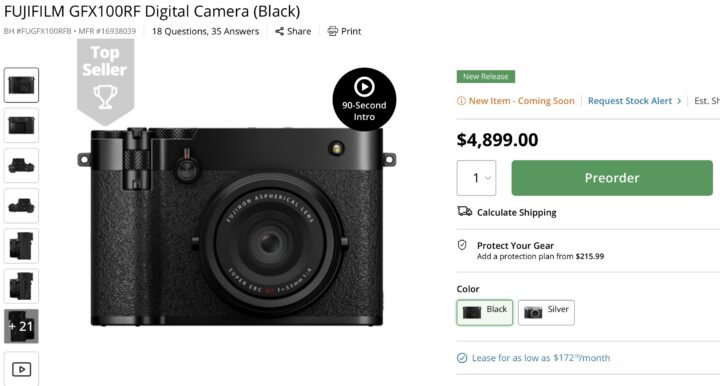Fujifilm GFX100RF Fujifilm Manager Interviews and Additional Reviews
The Fujifilm GFX100RF is collecting general praise all over the internet for just how incredibly small and light it is for a medium format camera, and also for its excellent build quality.
But of course they also address the fact that it does not have IBIS.
Now, you can read more about it below, but in general it seems the consensus is that at 1/30th you can still get away with sharp images, but below that it starts to get tricky. That’s according to Luca Petralia (review below) and docma (article in German below) and also to the Vistek video we shared in our live blog. Of course I have not tested it myself (I am just a mere mortal like you and I don’t get anything from Fujifilm unless I pay full price for it), so for now I will just report what reviewers have to say about it.
Out of curiosity I checked the shutter speeds of my last few hundred images, and I found one at 1/33th, one at 1/50th a few at 1/60th and 1/80th but mostly I am well over that. So if the statements of reviewers so far holds true, if I were to use the GFX100RF with my style of shooting I could live very well without IBIS. Of course I have shots at even slower shutter speeds, but for those I used a tripod anyway, as I was working either in blue hour landscape/cityscape or with filters and I needed exposures of multiple seconds.
With that said, here are the reviews I mentioned above as well as a few more, including interviews with Fujifilm managers that while nice to listen at, do not really disclose anything new, hence I did not dedicate them a specific article but I decided to include them in this roundup.
- Fujifilm GFX100RF
USA: BHphoto / AmazonUS (silver – black) / Adorama / Moment / Nuzira / BestBuy
CAN: AmazonCA - Fujifilm GFX100RF in EU/UK
UK: WexPhotoVideoUK / AmazonUK / ParkCameraUK
GER: AmazonDE / CalumetDE / FotoErhardt / Fotokoch
EUR: 50.8 Shop / PCHstore / AmazonFR / AmazonIT / AmazonES / AmazonNL
Worldwide: Amazon of Your Country
Fujifilm GFX100RF Reviews
& Manager Interviews
Writte Reviews
- keithwee – Fujifilm GFX100RF review – Dreams do come true
- docma (original German) – Small on the outside, big on the inside: The Fuji GFX100RF (with samples at 1/30th of a second)
Video Reviews and Interviews
CineD Interview
- biggest challenge was to make it smaller and smaller
- no IBIS or OIS allows to make it as small and light and make it a carry around daily camera
- Fujifilm tested several focal lengths and apertures and 35mmF4 was the best balance in terms of size
- the lens is “mount-free” and goes inside the camera, whereas interchangable lenses for GFX have a certain flange focal distance
- F-Log 2C could techinically implemented in future via firmware update
- GFX100RF can not support open gate
Petapixel met with Fujifilm US manager Justin Stailey, who is the only Western manager on a camera product development team that Petapixel is aware of.
To tell you one thing: Justin is the guy who gave Fujifilm the idea of Fujifilm’s most brilliant dial. So we ow that guy a lot ;).
- GFX100RF is size of an X-Pro basically
- size was priority when making this camera
- the theme was “small cameras, big pictures” and “everyday carry”
- target are people looking for more image quality. They are probably not professional image makers, but have a passion for photography
- X100 is a great gateway into X system
- those who want an X100 like camera but not APS-C, now Fuji offers GFX100RF
- 28mm eds up being the sweetspot of when you can get the best handheld images with slowest speed, etc
- there is always a reason for Fujifilm’s decision
- 100MP gives flexibility with crops and aspect ratio
- Chris says he can handhold annd slow shutter speeds well due to 28mm
- GFX100RF is small and easy to always have with you
- Justin thinks it will be used for streets and documentary, but also architects and filmmakers that want to document what they see. Also for people who want to make big prints
- Fujifilm pays attention to what other brands are doing. But when Fuji looks at products, they hear at customers but also at what Fujifilm thinks is creative and what kind of solutions they want
- there are some really good image makers inside the Fujifilm camera company
- Fujifilm enjoys photography and has passion for it


